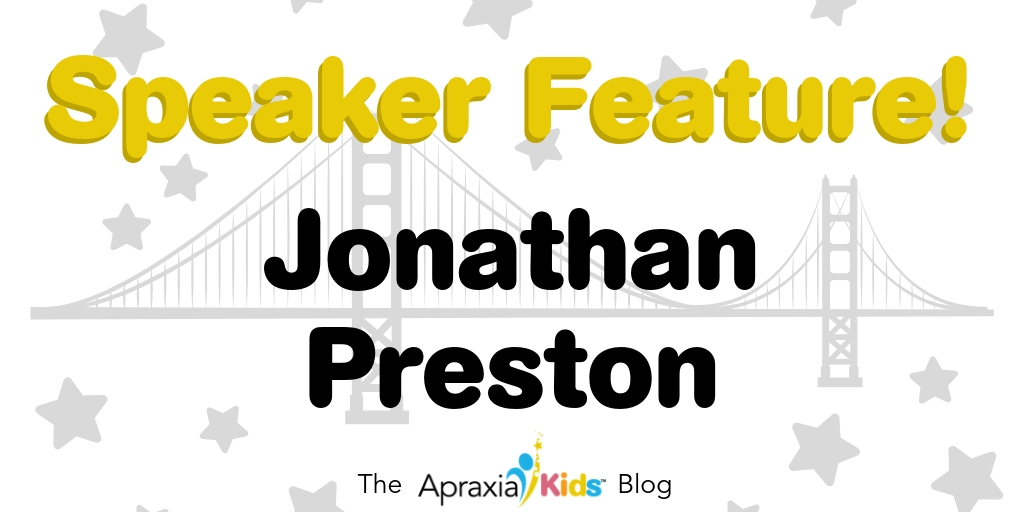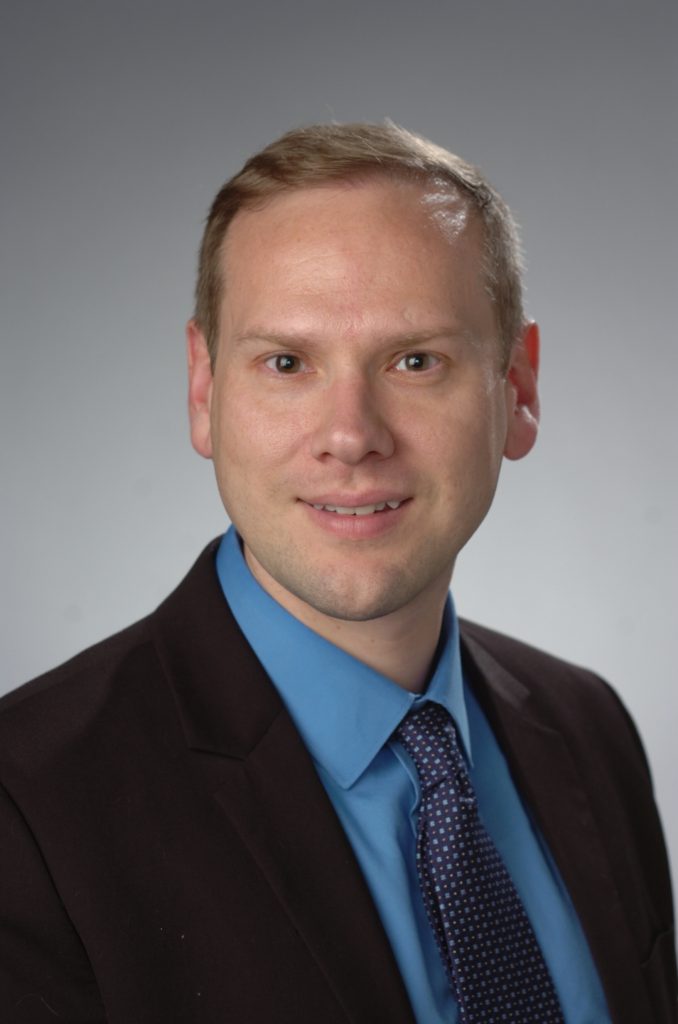
18 Apr SPEAKER FEATURE: Dr. Jonathan Preston
With the 2019 Apraxia Kids National Conference just around the corner, we are excited to feature some of our outstanding speakers for this year!

Dr. Jonathan Preston is a speech-language pathologist who has been working with children with speech sound disorders for 15 years. He received his PhD from Syracuse University in 2008 and completed postdoctoral training at Haskins Laboratories, an affiliate of Yale University. He is an Associate Professor in the Communication Sciences and Disorders Department at Syracuse University. His research focuses on evidence based treatments for speech sound disorders. He currently has a grant from the National Institutes of Health to study biofeedback treatments and different service delivery models for children with persisting speech sound errors associated with CAS.
Dr. Preston is presenting two sessions this year. First, “Ultrasound Visual Biofeedback: A Hands-On Experience” alongside Megan Leece, MA, CCC-SLP and Caitlin Vose, PhD, CCC-SLP.
Course Abstract: Research has shown that children with CAS can improve speech sound production skills during treatment programs that include real-time visual feedback technologies such as ultrasound. Visual feedback is intended to enhance feedback to improve a clinician’s cueing, as well as enhance a child’s feedback and recognition of articulatory errors. We will provide an overview of visual feedback, including the strengths and the limitations of the approach. We will discuss candidacy (i.e., older children approximately ages 7 years and above with good visual and cognitive skills). We will summarize the literature on ultrasound visual feedback, currently consisting of single case experimental designs with replication; that is, targeted speech movement patterns have been shown to improve in about 75% of cases of children with persisting speech errors (including derhotacized /r/, lateralized sibilants, fronted velars, or backed alveolars).
Second, you can join Dr. Preston in “Using Speech Motor Chaining to Treat School-Aged Children” alongside Megan Leece, MA, CCC-SLP.
Course Abstract: Speech Motor Chaining is an operationalized treatment for school-aged children with CAS. This structured form of practice is designed to help transition from a focus on acquisition of targets (i.e., successful performance within a session) towards a focus on speech motor learning. The approach has been used to guide the treatment structure for 6 published studies, and we have used the practice structure both with and without visual feedback. A tutorial about the approach has recently been published (Preston, Leece & Storto, in press). Speech Motor Chaining involves stimuli that are chained around a core movement pattern (typically a CV or VC syllable). For example, onset /s/ may be forward chained in targets such as /si/, seed, seedling, plant a seedling, or backward chained as in /si/, seat, receipt, gift receipt. In this session, attendees will be given an opportunity to both see the treatment and to practice using it.
Apraxia Kids asked Dr. Preston a few questions about his upcoming sessions:
Apraxia Kids: Why are you excited to present at this year’s Apraxia Kids National Conference?
Jonathan: It’s a great way to connect with colleagues and to discuss different approaches to treating CAS.
Apraxia Kids: What can conference attendees expect from your presentation?
Jonathan: For the “Hands-on training: Ultrasound visual feedback for treating persisting speech errors” session, SLPs can learn about how visually representing speech with ultrasound may improve their treatment. For the “How to use Speech Motor Chaining to treat School-age Children with CAS” session, SLPs can learn about an evidence-based approach for structuring practice around principles of motor learning.
Apraxia Kids: What are you most excited to share in your session?
Jonathan: We will provide lots of treatment examples and we will support attendees in practicing the strategies we discuss.
Apraxia Kids: If you have attended the conference before, what is your favorite part of attending? If you have not attended the conference before, what are you most looking forward to?
Jonathan: This is the only conference I know of that includes parents, researchers, and clinicians. It provides a unique, educational, relatively informal atmosphere to discuss the different perspectives on CAS.
Interested in learning more about all of our National Conference presentations? Click here to view the full schedule!
With the 2019 Apraxia Kids National Conference just around the corner, we are excited to feature some of our outstanding speakers for this year!

Dr. Jonathan Preston is a speech-language pathologist who has been working with children with speech sound disorders for 15 years. He received his PhD from Syracuse University in 2008 and completed postdoctoral training at Haskins Laboratories, an affiliate of Yale University. He is an Associate Professor in the Communication Sciences and Disorders Department at Syracuse University. His research focuses on evidence based treatments for speech sound disorders. He currently has a grant from the National Institutes of Health to study biofeedback treatments and different service delivery models for children with persisting speech sound errors associated with CAS.
Dr. Preston is presenting two sessions this year. First, “Ultrasound Visual Biofeedback: A Hands-On Experience” alongside Megan Leece, MA, CCC-SLP and Caitlin Vose, PhD, CCC-SLP.
Course Abstract: Research has shown that children with CAS can improve speech sound production skills during treatment programs that include real-time visual feedback technologies such as ultrasound. Visual feedback is intended to enhance feedback to improve a clinician’s cueing, as well as enhance a child’s feedback and recognition of articulatory errors. We will provide an overview of visual feedback, including the strengths and the limitations of the approach. We will discuss candidacy (i.e., older children approximately ages 7 years and above with good visual and cognitive skills). We will summarize the literature on ultrasound visual feedback, currently consisting of single case experimental designs with replication; that is, targeted speech movement patterns have been shown to improve in about 75% of cases of children with persisting speech errors (including derhotacized /r/, lateralized sibilants, fronted velars, or backed alveolars).
Second, you can join Dr. Preston in “Using Speech Motor Chaining to Treat School-Aged Children” alongside Megan Leece, MA, CCC-SLP.
Course Abstract: Speech Motor Chaining is an operationalized treatment for school-aged children with CAS. This structured form of practice is designed to help transition from a focus on acquisition of targets (i.e., successful performance within a session) towards a focus on speech motor learning. The approach has been used to guide the treatment structure for 6 published studies, and we have used the practice structure both with and without visual feedback. A tutorial about the approach has recently been published (Preston, Leece & Storto, in press). Speech Motor Chaining involves stimuli that are chained around a core movement pattern (typically a CV or VC syllable). For example, onset /s/ may be forward chained in targets such as /si/, seed, seedling, plant a seedling, or backward chained as in /si/, seat, receipt, gift receipt. In this session, attendees will be given an opportunity to both see the treatment and to practice using it.
Apraxia Kids asked Dr. Preston a few questions about his upcoming sessions:
Apraxia Kids: Why are you excited to present at this year’s Apraxia Kids National Conference?
Jonathan: It’s a great way to connect with colleagues and to discuss different approaches to treating CAS.
Apraxia Kids: What can conference attendees expect from your presentation?
Jonathan: For the “Hands-on training: Ultrasound visual feedback for treating persisting speech errors” session, SLPs can learn about how visually representing speech with ultrasound may improve their treatment. For the “How to use Speech Motor Chaining to treat School-age Children with CAS” session, SLPs can learn about an evidence-based approach for structuring practice around principles of motor learning.
Apraxia Kids: What are you most excited to share in your session?
Jonathan: We will provide lots of treatment examples and we will support attendees in practicing the strategies we discuss.
Apraxia Kids: If you have attended the conference before, what is your favorite part of attending? If you have not attended the conference before, what are you most looking forward to?
Jonathan: This is the only conference I know of that includes parents, researchers, and clinicians. It provides a unique, educational, relatively informal atmosphere to discuss the different perspectives on CAS.
Interested in learning more about all of our National Conference presentations? Click here to view the full schedule!
Credentials:
Hours of Operation:
Treatment locations:
Address:
,
Phone:
Email:
Overall Treatment Approach:
Percent of CAS cases:
Parent Involvement:
Community Involvement:
Professional consultation/collaboration:
Min Age Treated:
Max Age Treated:
Insurance Accepted:




